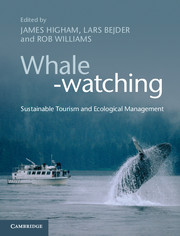Book contents
- Frontmatter
- Dedication
- Contents
- Acknowledgements
- List of contributors
- List of abbreviations
- 1 Tourism, cetaceans and sustainable development
- Part I The historical and contemporary contexts
- Part II Human dimensions of whale-watching
- Part III Ecological dimensions of whale-watching
- Part IV Sustainable management: insights and issues
- 18 The socioeconomic, educational and legal aspects of whale-watching
- 19 Vigilance, resilience and failures of science and management
- 20 Insights from agent-based modelling to simulate whale-watching tours
- 21 Cetacean-watching in developing countries
- 22 Kaikoura (New Zealand)
- 23 Management of dusky dolphin tourism at bKaikoura, New Zealand
- 24 Save the whales Part II
- 25 Time to rethink
- Index
- Plate Section
- References
18 - The socioeconomic, educational and legal aspects of whale-watching
A Scottish case study
from Part IV - Sustainable management: insights and issues
Published online by Cambridge University Press: 05 April 2014
- Frontmatter
- Dedication
- Contents
- Acknowledgements
- List of contributors
- List of abbreviations
- 1 Tourism, cetaceans and sustainable development
- Part I The historical and contemporary contexts
- Part II Human dimensions of whale-watching
- Part III Ecological dimensions of whale-watching
- Part IV Sustainable management: insights and issues
- 18 The socioeconomic, educational and legal aspects of whale-watching
- 19 Vigilance, resilience and failures of science and management
- 20 Insights from agent-based modelling to simulate whale-watching tours
- 21 Cetacean-watching in developing countries
- 22 Kaikoura (New Zealand)
- 23 Management of dusky dolphin tourism at bKaikoura, New Zealand
- 24 Save the whales Part II
- 25 Time to rethink
- Index
- Plate Section
- References
Summary
Introduction
Between 1995 and 2000 the International Fund for Animal Welfare (IFAW) held a number of workshops on various aspects of whale-watching. The first discussed the scientific aspects (IFAW, 1995) of the activity, but in 1997 there were three workshops on the more social and managerial aspects of the industry, including a workshop on the educational impacts of whale-watching (IFAW, 1997) which also included debate about ways to persuade whale-watching operators to use codes of conduct to minimize their impacts, and another workshop on the legal aspects of whale-watching (IFAW, 2000). The third was on the socioeconomic impacts of whale-watching (IFAW, 1999). A global review of all of these aspects of whale-watching would arguably be a book, or books, by themselves. Therefore, this current chapter builds on some of the ideas and suggestions raised in these workshops for a specific case study in Scotland, an area where there has been substantive and quantitative research into these areas. The last workshop in the series mentioned above (IFAW, 2001) discussed issues such as the conflict between whale-watching and whaling in certain locations, and the potential negative socioeconomic impacts, and this is also briefly discussed in this chapter.
Whale-watching in Scotland
The first official whale-watching business (Sea-life Surveys) in Scotland, indeed for the entire UK, began in 1989 on the island of Mull. Hoyt (2001) estimated that there were at least 35 land- and boat-based whale-watching activities in Scotland by 1998. Hughes (2001) suggested that in the UK there was an overall growth in public interest to seeing cetaceans in the wild from the late 1980s onwards, and a move away from tourism involving captive cetaceans – indeed, all of the captive cetacean facilities in the UK had closed by the mid-1990s, whereas there was a positive growth in wild cetacean-watching opportunities, particularly in eastern Scotland, focused on the resident common bottlenose dolphin (Tursiops truncatus) population in the Moray Firth.
- Type
- Chapter
- Information
- Whale-watchingSustainable Tourism and Ecological Management, pp. 263 - 274Publisher: Cambridge University PressPrint publication year: 2014
References
- 1
- Cited by



